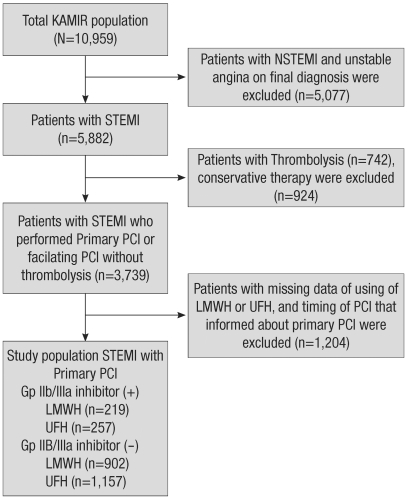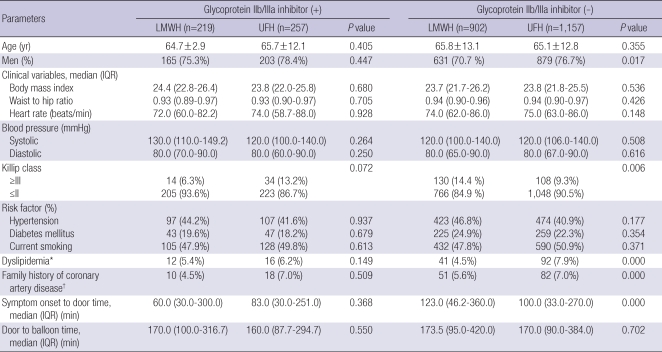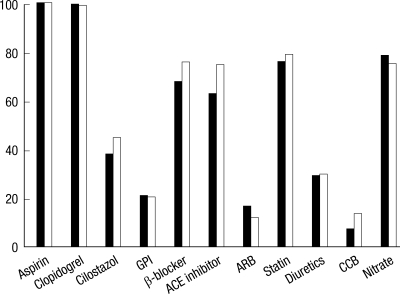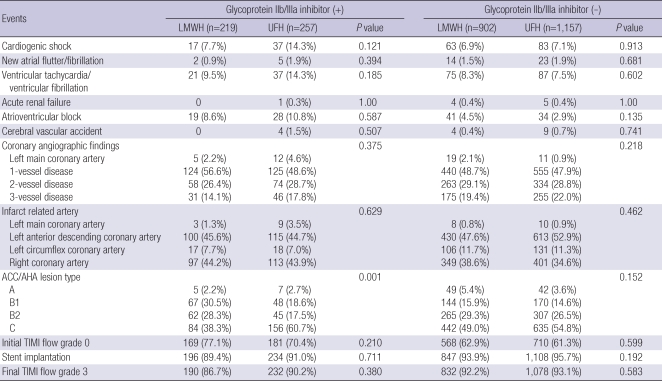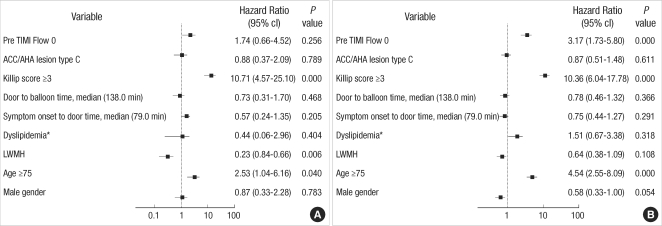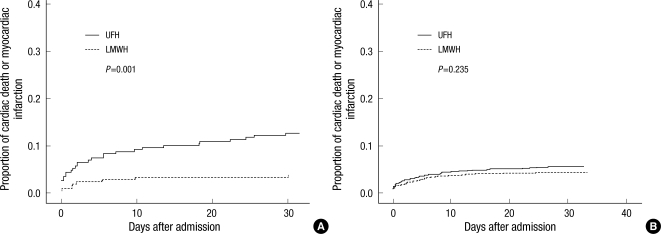Abstract
The efficacy of low molecular weight heparin (LMWH) with low dose unfractionated heparin (UFH) during percutaneous coronary intervention (PCI) with or without glycoprotein (Gp) IIb/IIIa inhibitor compared to UFH with or without Gp IIb/IIIa inhibitor has not been elucidated. Between October 2005 and July 2007, 2,535 patients with ST elevation acute myocardial infarction (STEMI) undergoing PCI in the Korean Acute Myocardial Infarction Registry (KAMIR) were assigned to either of two groups: a group with Gp IIb/IIIa inhibitor (n=476) or a group without Gp IIb/IIIa inhibitor (n=2,059). These groups were further subdivided according to the use of LMWH with low dose UFH (n=219) or UFH alone (n=257). The primary end points were cardiac death or myocardial infarction during the 30 days after the registration. The primary end point occurred in 4.1% (9/219) of patients managed with LMWH during PCI and Gp IIb/IIIa inhibitor and 10.8% (28/257) of patients managed with UFH and Gp IIb/IIIa inhibitor (odds ratio [OR], 0.290; 95% confidence interval [CI], 0.132-0.634; P=0.006). Thrombolysis In Myocardial Infarction (TIMI) with major bleeding was observed in LMHW and UFH with Gp IIb/IIIa inhibitor (1/219 [0.5%] vs 1/257 [0.4%], P=1.00). For patients with STEMI managed with a primary PCI and Gp IIb/IIIa inhibitor, LMWH is more beneficial than UFH.
Keywords: Myocardial Infarction, Heparin, Blood Platelets, Prognosis
INTRODUCTION
Several randomized large-scale studies have demonstrated that low molecular weight heparin (LMWH) is not inferior to unfractionated heparin (UFH) in the treatment of non-ST elevation acute myocardial infarction patients (1-3). In ST-elevation acute myocardial infarction (STEMI) patients receiving fibrinolytic therapy, LMWH is known to be better than UFH (4-7).
Furthermore, the FINESSE trial (Facilitated Intervention with Enhanced Reperfusion Speed to Stop Events) demonstrated that enoxaparin is beneficial as a primary and facilitated percutaneous coronary intervention (PCI) (8). However, the efficacy of LMWH compared to UFH with or without glycoprotein IIb/IIIa inhibitor (Gp IIb/IIIa inhibitor) has not yet been elucidated in patients with STEMI, though co-medication of UFH with Gp IIb/IIIa inhibitor has been demonstrated to attenuate platelet inhibition in a few studies (9-12).
The aim of this analysis of a non-randomized, prospective registry was to determine whether LMWH during PCI with Gp IIb/IIIa inhibitor for patients undergoing primary PCI was more beneficial than UFH with Gp IIb/IIIa inhibitor.
MATERIALS AND METHODS
Study population
KAMIR is a Korean, prospective, open, observational, multicenter, on-line registry of patients with acute myocardial infarction (AMI) started in November 2005 with support from the Korean Society of Cardiology. The 50 participating hospitals are capable of primary PCI. Details of the KAMIR have been published (13-18). From November 2005 to January 2008, 10,959 patients with a final diagnosis of AMI were enrolled in the KAMIR. Of these patients, 3,739 patients with STEMI underwent primary or facilitated PCI; a total of 1,204 patients were excluded from the analysis because of missing data of the detailed use LMWH or UFH or timing of PCI data (Fig. 1).
Fig. 1.
Flow chart of patients who entered the study.
KAMIR, Korean Acute Myocardial Infarction Registry; STEMI, ST-elevation myocardial infarction; LMWH, low molecular weight heparin; PCI, percutaneous coronary intervention; UFH, unfractionated heparin.
Patients with STEMI managed with primary PCI and Gp IIb/IIIa inhibitor were divided into two groups; the two groups included patients managed with Gp IIb/IIIa inhibitor and LMWH during PCI (n=219) or patients managed with Gp IIb/IIIa inhibitor and UFH alone (n=257). Patients managed with primary PCI without Gp IIb/IIIa inhibitor were also divided into two groups; patients using LMWH during PCI (n=902) or patients using UFH alone (n=1,157).
ST-segment elevation MI was defined by new ST elevation in ≥2 contiguous leads, measuring >0.2 mV in leads V1 to V3, or 0.1 mV in all other leads. Primary PCI was defined as emergency PCI performed within 12 hr after admission. Most of the patients in the LMWH group received subcutaneous enoxaparin (Clexane®; Bristol-Myers Squibb, New York, USA and Sanofi-Aventis, Paris, France) 1 mg/kg B.i.d. for 3-5 days from the emergency room plus a reduced dose of UFH (50 U/kg). Patients of the UFH group received a bolus of UFH 5,000 U in the emergency room, and 50-70 U/kg were given during the primary PCI followed by 24,000 U/day infusions for 2 days. Platelet glycoprotein IIb/IIIa receptor blockers during the index PCI were used at the decision of the interventional cardiologists. All patients received a loading dose of 200-300 mg aspirin and 300-600 mg clopidogrel. Cilostazol as the third antiplatelet agent was left to the individual operator's decision. Epicardial coronary blood flow in the infarct-related artery before and after stent implantation was graded according to the classification used in the Thrombolysis In Myocardial Infarction (TIMI) trials. Successful PCI was defined as a residual stenosis <50% in diameter with final grade 3 TIMI flow.
Clinical endpoints
The primary endpoints of the study were cardiac death or recurrent MI during 30 days. The primary safety outcome was TIMI major bleeding. Secondary outcome measures included the incidence of cardiac death or recurrent MI at 14 days.
Statistical analysis
Data are expressed as mean±SD or medians with interquartile ranges for continuous variables and percentage for categorized as UFH alone with Gp IIb/IIIa inhibitor or LMWH with low dose UFH during PCI and Gp IIb/IIIa inhibitor. Comparisons between baseline variables were made via the Pearson chi-square test. Comparisons of major adverse cardiac events (MACE) rates in groups were adjusted according to baseline variables using Cox proportional hazards models. Multiple logistic regression analysis was used to estimate the relative risk for mortality in 30 days. In all statistical tests, a 2-sided P value <0.05 was considered statistically significant. Statistical analysis was performed using SPSS 15.0 for Windows (SPSS, Inc., Chicago, IL, USA). Survival analysis was estimated using the Kaplan-Meier method with log-rank tests to compare survival between groups.
Ethics statement
Korea Acute Myocardial Infarction Registry was approved by Institutional Review Board of Chonnam National University Hospital (IRB No. I-2008--1-009) and informed consents were obtained from all registered patients.
RESULTS
Patient population
A total of 2,535 patients had STEMI managed with primary PCI (Fig. 1). Clinical characteristics and laboratory findings of four groups, the LMWH and UFH group with Gp IIb/IIIa inhibitors (LMWH, n=219; UFH, n=257) and without Gp IIb/IIIa inhibitors (LMWH, n=902; UFH, n=1,157) are listed in Tables 1 and 2. Rates of dyslipidemia and a family history of coronary artery disease were higher in the UFH group without Gp IIb/IIIa inhibitor than in the LMWH group without Gp IIb/IIIa inhibitor (92/1,157 [7.9%] vs 41/902 [4.5%], P<0.001; 82/1,157 [7.0%] vs 51/902 [5.6%], P<0.001 [Table 1]). The median time from symptom onset to door time was longer in the LMWH group without Gp IIb/IIIa inhibitor than in the UFH group without Gp IIb/IIIa inhibitor (123 min [46.2-360.0] vs 100.0 min [33.0-270.0], P<0.001 [Table 1]), but the median time from arrival to ballooning was not different between the two groups (173.5 min [95.0-420.0] vs 170.0 min [90.0-384.0] P=0.702). There were no differences in laboratory findings between the two groups, except that high-sensitivity C-reactive protein was higher in the UFH with Gp IIb/IIIa inhibitor group than in the LMWH with Gp IIb/IIIa inhibitor group (2.36±3.79 mg/dL vs 4.27±6.10 mg/dL, P=0.003 [Table 2]).
Table 1.
Clinical characteristics in patients
Data are expressed as medians with interquartile ranges.
*Defined as previously diagnosed by a physician and/or receiving lipid lowering drugs; †Defined as coronary heart disease in first-degree male relative <55 yr old or coronary heart disease in first-degree female relative <65 yr old.
LMWH, low molecular weight heparin; UFH, unfractionated heparin; IQR, interquartile range.
Table 2.
Laboratory findings
Data expressed as mean±SE.
LMWH, low molecular weight heparin; UFH, unfractionated heparin.
Antithrombotic regimen and antiplatelet medication
Platelet glycoprotein IIb/IIIa receptor blockers during index PCI were used at the decision of the interventional cardiologists. The rate of use of cilostazol in addition to dual antiplatelet medications was higher in the UFH group compared to the LMWH group (263/692 [38.0%] vs 418/930 [44.8%], P=0.006) (Fig. 2).
Fig. 2.
Concomitant medications during hospitalization.
GPI, glycoprotein IIb/IIIa inhibitor; ACE, angiotensin converting enzyme; ARB, aldosterone receptor inhibitor; CCB, calcium channel blocker.
Procedures
All the patients underwent primary PCI. Stents were implanted in 89.4% of patients in the LMWH with Gp IIb/IIIa inhibitor group, 91.0% of patients in the UFH with Gp IIb/IIIa inhibitor group, 93.9% of patients in the LMWH without Gp IIb/IIIa inhibitor group, and 95.7% of patients in the UFH without Gp IIb/IIIa inhibitor group. The number of diseased coronary arteries was not different between the LMWH and UFH groups with and without Gp IIb/IIIa inhibitor. There were no significant differences between patients of both groups in the initial TIMI flow grade and the final TIMI flow grade (LMWH plus low dose UFH during PCI with Gp IIb/IIIa inhibitor and UFH with Gp IIb/IIIa inhibitor initial TIMI grade 0, 169/219 [77.1%] vs 181/257 [70.4%], P=0.210; final TIMI grade 3, 190/219 [86.7%] vs 232/257 [90.2%], P=0.380 [Table 3]). Lesion types according to the American College of Cardiology/American Heart Association criteria were more complex in the UFH with Gp IIb/IIIa inhibitor group than in the LMWH with Gp IIb/IIIa inhibitor group (Table 3).
Table 3.
In-hospital events and procedures through 30 days
Data expressed as number of patients (percentage).
ACC/AHA, American College of Cardiology/American Heart Association; TIMI, Thrombolysis In Myocardial Infarction.
Multivariate analysis
Use of LMWH was an independent predictor of mortality and MI at 30 days in groups managed with primary PCI with Gp IIb/IIIa inhibitor. High Killip score (≥3), and old age (≥75 yr) were also independent predictors of the primary end point in groups managed with primary PCI with and without Gp IIb/IIIa inhibitor (Fig. 3).
Fig. 3.
Hazard ratio plots of independent predictors with the multivariable analyses for death or myocardial infarction in 30 days in UFH and LMWH groups with glycoprotein IIb/IIIa inhibitor (A) and without glycoprotein IIb/IIIa inhibitor (B) in STEMI patients who underwent primary PCI.
*Defined as coronary heart disease in first-degree male relative <55 yr old or coronary heart disease in first-degree female relative <65 yr old.
LMWH, low molecular weight heparin; UFH, unfractionated heparin; STEMI, ST-elevation myocardial infarction; PCI, percutaneous coronary intervention.
Clinical outcomes
The primary end point occurred in 4.1% (9/219) of patients managed with LMWH with low dose UFH during PCI with Gp IIb/IIIa inhibitor and 10.8% (28/191) of patients managed with UFH alone with Gp IIb/IIIa inhibitor (Odds ratio [OR], 0.290; 95% confidence interval [CI], 0.132-0.634; P=0.001 [Table 4, Fig. 4]). There was no significant occurrence of the primary end point in the LMWH and UFH groups without Gp IIb/IIIa inhibitor (OR, 0.870; 95% CI, 0.527-1.437; P=0.250 [Table 4]).
Table 4.
Primary outcomes at 14 and 30 days
Data expressed as number of patients (percentage).
Fig. 4.
Kaplan-Meier analysis of primary endpoint of UFH and LMWH groups with glycoprotein IIb/IIIa inhibitor (A) and without glycoprotein IIb/IIIa inhibitor (B) in STEMI patients who underwent primary PCI.
LMWH, low molecular weight heparin; UFH, unfractionated heparin; STEMI, ST-elevation myocardial infarction; PCI, percutaneous coronary intervention.
TIMI major bleeding was observed with LMWH with low dose UFH and UFH alone with Gp IIb/IIIa inhibitor and without Gp IIb/IIIa inhibitor (1/219 [0.5%] vs 1/257 [0.4%], P=1.00; 0/902 [0%] vs 3/1157 [0.3%], P=0.261 [Table 4]).
DISCUSSION
In the present study, the effectiveness of LMWH with Gp IIb/IIIa inhibitor for STEMI patients undergoing primary PCI is beneficial compared to UFH with Gp IIb/IIIa inhibitor. The rate of cardiac death or myocardial infarction in 30 days was lower in the LMWH with low dose UFH during PCI with Gp IIb/IIIa inhibitor group than in the UFH with Gp IIb/IIIa inhibitor group. Heparin has been reported to modify platelet function in vitro and in vivo in both patients and healthy individuals. In vitro, low doses of heparin are more apt to reduce platelet aggregation, while high doses are more likely to increase it (19, 20). In unstable angina, UFH increased the percentage of activated platelets, and platelets became hyperresponsive to stimulation with adenosine diphosphate (ADP) and thrombin receptor agonist peptide (TRAP) (11). Several clinical studies, including the GOLD study, IMPACT II, and the GUSTO IV-ACS trials, demonstrated the adverse effects of concomitant UFH and Gp IIb/IIIa inhibitor administration (21-23). LMWH may be less likely than UFH to induce platelet activation (10, 11, 24).
LMWH is more convenient than UFH as it has a more stable and predictable dose response. Anti-Xa levels correlate with the anticoagulant effects of LMWH but cannot be routinely monitored in the catheterization laboratory (3). LMWH reduces ischemic events more effectively than UFH in patients treated conservatively for non-ST-segment elevation acute coronary syndrome. Furthermore, in high-risk patients undergoing early percutaneous coronary intervention for acute coronary syndrome, LMWH avoids the need for monitoring and achieves similar effectiveness to UFH but has been associated with more bleeding (3).
According to a 2007 meta-analysis of trials, including the ASSENT-3 trial, ASSEMT-3 PLUS trial, and ExTRACT-TIMI 25 trial, which compared UFH to LMWH in over 27,000 STEMI patients receiving fibrinolytic therapy, LMWH was shown to be better than UFH in ST-elevation acute myocardial infarction (STEMI) patients receiving fibrinolytic therapy (23-25). Furthermore, a substudy of the FINESSE trial (Facilitated INtervention with Enhanced Reperfusion Speed to Stop Events showed that enoxaparin was beneficial in primary and facilitated percutaneous coronary intervention (8). In the KAMIR data, enoxaparin plus a reduced dose of UFH (50 U/kg) during PCI in acute STEMI patients undergoing primary PCI with drug-eluting stents (DES) showed lower incidences of in-hospital cardiac deaths and total deaths compared to those from UFH alone (18). However, medications including Gp IIb/IIIa inhibitors in both groups were different in this study. As a result, we considered the benefits of concomitant LMWH administration with Gp IIb/IIIa inhibitor (21-23, 26, 27). In the present study, the group that received Gp IIb/IIIa inhibitor showed more benefits of LMWH with low dose UFH during PCI than UFH alone, the group without Gp IIb/IIIa inhibitor did not.
This study has several limitations. KAMIR is the largest registry of patients with acute myocardial infarction in Korea. We could not analyze the relationship between anticoagulant dose and risk of bleeding, and laboratory finding of activated partial thromboplastin time. The use of Gp IIb/IIIa inhibitor was limited due to medical insurance in Korea. Therefore Gp IIb/IIIa could be used in very high-risk patients with STEMI. This analysis needs a large scale, randomized prospective study to form conclusive results. Platelet glycoprotein IIb/IIIa receptor blockers during PCI were used at the discretion of the interventional cardiologists.
In conclusion, for STEMI patients managed with a primary PCI and Gp IIb/IIIa inhibitor, LMWH plus a reduced dose of UFH (50 U/kg) during PCI is more beneficial than UFH.
Footnotes
This study was performed with the support of The Korean Society of Circulation in the memorandum of the 50th Anniversary of The Korean Society of Circulation.
References
- 1.Collet JP, Montalescot G, Agnelli G, Van de Werf F, Gurfinkel EP, López-Sendón J, Laufenberg CV, Klutman M, Gowda N, Gulba D GRACE Investigators. Non-ST-segment elevation acute coronary syndrome in patients with renal dysfunction: benefit of low-molecular-weight heparin alone or with glycoprotein IIb/IIIa inhibitors on outcomes. The Global Registry of Acute Coronary Events. Eur Heart J. 2005;26:2285–2293. doi: 10.1093/eurheartj/ehi337. [DOI] [PubMed] [Google Scholar]
- 2.Ferguson JJ, Califf RM, Antman EM, Cohen M, Grines CL, Goodman S, Kereiakes DJ, Langer A, Mahaffey KW, Nessel CC, Armstrong PW, Avezum A, Aylward P, Becker RC, Biasucci L, Borzak S, Col J, Frey MJ, Fry E, Gulba DC, Guneri S, Gurfinkel E, Harrington R, Hochman JS, Kleiman NS, Leon MB, Lopez-Sendon JL, Pepine CJ, Ruzyllo W, Steinhubl SR, Teirstein PS, Toro-Figueroa L, White H SYNERGY Trial Investigators. Enoxaparin vs. unfractionated heparin in high-risk patients with non-ST-segment elevation acute coronary syndromes managed with an intended early invasive strategy: primary results of the SYNERGY randomized trial. JAMA. 2004;292:45–54. doi: 10.1001/jama.292.1.45. [DOI] [PubMed] [Google Scholar]
- 3.White HD, Kleiman NS, Mahaffey KW, Lokhnygina Y, Pieper KS, Chiswell K, Cohen M, Harrington RA, Chew DP, Petersen JL, Berdan LG, Aylward PE, Nessel CC, Ferguson JJ, 3rd, Califf RM. Efficacy and safety of enoxaparin compared with unfractionated heparin in high-risk patients with non-ST-segment elevation acute coronary syndrome undergoing percutaneous coronary intervention in the Superior Yield of the New Strategy of Enoxaparin, Revascularization and Glycoprotein IIb/IIIa Inhibitors (SYNERGY) trial. Am Heart J. 2006;152:1042–1050. doi: 10.1016/j.ahj.2006.08.002. [DOI] [PubMed] [Google Scholar]
- 4.Assessment of the Safety and Efficacy of a New Thrombolytic Regimen (ASSENT)-3 Investigators. Efficacy and safety of tenecteplase in combination with enoxaparin, abciximab, or unfractionated heparin: the ASSENT-3 randomized trial in acute myocardial infarction. Lancet. 2001;358:605–613. doi: 10.1016/S0140-6736(01)05775-0. [DOI] [PubMed] [Google Scholar]
- 5.Wallentin L, Goldstein P, Armstrong PW, Granger CB, Adgey AA, Arntz HR, Bogaerts K, Danays T, Lindahl B, Mäkijärvi M, Verheugt F, Van de Werf F. Efficacy and safety of tenecteplase in combination with the low-molecular-weight heparin enoxaparin or unfractionated heparin in the prehospital setting: the Assessment of the Safety and Efficacy of a New Thrombolytic Regimen (ASSENT)-3 PLUS randomized trial in acute myocardial infarction. Circulation. 2003;108:135–142. doi: 10.1161/01.CIR.0000081659.72985.A8. [DOI] [PubMed] [Google Scholar]
- 6.Antman EM, Morrow DA, McCabe CH, Murphy SA, Ruda M, Sadowski Z, Budaj A, López-Sendón JL, Guneri S, Jiang F, White HD, Fox KA, Braunwald E ExTRACT-TIMI 25 Investigators. Enoxaparin versus unfractionated heparin with fibrinolysis for ST-elevation myocardial infarction. N Engl J Med. 2006;354:1477–1488. doi: 10.1056/NEJMoa060898. [DOI] [PubMed] [Google Scholar]
- 7.Montalescot G, White HD, Gallo R, Cohen M, Steg PG, Aylward PE, Bode C, Chiariello M, King SB, 3rd, Harrington RA, Desmet WJ, Macaya C, Steinhubl SR STEEPLE Investigators. Enoxaparin versus unfractionated heparin in elective percutaneous coronary intervention. N Engl J Med. 2006;355:1006–1017. doi: 10.1056/NEJMoa052711. [DOI] [PubMed] [Google Scholar]
- 8.Montalescot G, Ellis SG, de Belder MA, Janssens L, Katz O, Pluta W, Ecollan P, Tendera M, van Boven AJ, Widimsky P, Andersen HR, Betriu A, Armstrong P, Brodie BR, Herrmann HC, Neumann FJ, Effron MB, Lu J, Barnathan ES, Topol EJ Facilitated Intervention with Enhanced Reperfusion Speed to Stop Events Investigators. Enoxaparin in primary and facilitated percutaneous coronary intervention A formal prospective non-randomized substudy of the FINESSE trial (Facilitated INtervention with Enhanced Reperfusion Speed to Stop Events) JACC Cardiovasc Interv. 2010;3:203–212. doi: 10.1016/j.jcin.2009.11.012. [DOI] [PubMed] [Google Scholar]
- 9.Klinkhardt U, Graff J, Westrup D, Kirchmaier CM, Esslinger HU, Breddin HK, Harder S. Pharmacodynamic characterization of the interaction between abciximab or tirofiban with unfractionated or a low molecular weight heparin in healthy subjects. Br J Clin Pharmacol. 2001;52:297–305. doi: 10.1046/j.0306-5251.2001.01446.x. [DOI] [PMC free article] [PubMed] [Google Scholar]
- 10.Xiao Z, Theroux P. Platelet activation with unfractionated heparin at therapeutic concentrations and comparisons with a low molecular-weight heparin and with a direct thrombin inhibitor. Circulation. 1998;97:251–256. doi: 10.1161/01.cir.97.3.251. [DOI] [PubMed] [Google Scholar]
- 11.Westwick J, Scully MF, Poll C, Kakkar W. Comparison of low molecular weight heparin and unfractionated heparin on activation of human platelets in vitro. Thromb Res. 1986;42:435–447. doi: 10.1016/0049-3848(86)90207-0. [DOI] [PubMed] [Google Scholar]
- 12.Deliargyris EN, Upadhya B, Melton LG, Thompson C, Fisher M, Gabriel DA, Dehmer GJ, Sane DC. Unfractionated heparin reduces the anti-platelet effects of abciximab but not eptifibatide during PCI. Clin Appl Thromb Hemost. 2006;12:458–464. doi: 10.1177/1076029606293432. [DOI] [PubMed] [Google Scholar]
- 13.Lee SR, Jeong MH, Ahn YK, Chae SC, Hur SH, Kim YJ, Seong IW, Chae JK, Hong TJ, Rhew JY, Cho MC, Bae JH, Rha SW, Kim CJ, Jang YS, Park SJ Korea Acute Myocardial Infarction Registry Investigators. Clinical safety of drug-eluting stents in the Korea Acute Myocardial Infarction Registry. Circ J. 2008;72:392–398. doi: 10.1253/circj.72.392. [DOI] [PubMed] [Google Scholar]
- 14.Lee SH, Park JS, Kim W, Shin DG, Kim YJ, Kim DS, Choi DJ, Han KR, Kim CJ, Cho MC, Chae SC, Jeong MH Korean Acute Myocardial Infarction Registry Investigators. Impact of body mass index and waist-to-hip ratio on clinical outcomes in patients with ST-segment elevation acute myocardial infarction (from the Korean Acute Myocardial Infarction Registry) Am J Cardiol. 2008;102:957–965. doi: 10.1016/j.amjcard.2008.06.022. [DOI] [PubMed] [Google Scholar]
- 15.Song YB, Hahn JY, Gwon HC, Kim JH, Lee SH, Jeong MH KAMIR investigators. The impact of initial treatment delay using primary angioplasty on mortality among patients with acute myocardial infarction: from the Korea Acute Myocardial Infarction Registry. J Korean Med Sci. 2008;23:357–364. doi: 10.3346/jkms.2008.23.3.357. [DOI] [PMC free article] [PubMed] [Google Scholar]
- 16.Lee JH, Park HS, Chae SC, Cho Y, Yang DH, Jeong MH, Kim YJ, Kim KS, Hur SH, Seong IW, Hong TJ, Cho MC, Kim CJ, Jun JE, Park WH Korea Acute Myocardial Infarction Registry Investigators. Predictors of six-month major adverse cardiac events in 30-day survivors after acute myocardial infarction (from the Korea Acute Myocardial Infarction Registry) Am J Cardiol. 2009;104:182–189. doi: 10.1016/j.amjcard.2009.03.010. [DOI] [PubMed] [Google Scholar]
- 17.Kwon TG, Bae JH, Jeong MH, Kim YJ, Hur SH, Seong IW, Cho MC, Seung KB, Jang YS, Park SJ Korea Acute Myocardial Infarction Registry Investigators. N-terminal pro-B-type natriuretic peptide is associated with adverse short-term clinical outcomes in patients with acute ST-elevation myocardial infarction underwent primary percutaneous coronary intervention. Int J Cardiol. 2009;133:173–178. doi: 10.1016/j.ijcard.2007.12.022. [DOI] [PubMed] [Google Scholar]
- 18.Li YJ, Rha SW, Chen KY, Poddar KL, Jin Z, Minami Y, Wang L, Dang Q, Li GP, Ramasamy S, Park JY, Choi CU, Kim JW, Kim EJ, Park CG, Seo HS, Oh DJ, Jeong MH, Ahn YK, Hong TJ, Park JS, Kim YJ, Hur SH, Seong IW, Chae JK, Cho MC, Bae JH, Choi DH, Jang YS, Chae IH, Kim HS, Kim CJ, Yoon JH, Ahn TH, Tahk SJ, Chung WS, Seung KB, Park SJ other Korea Acute Myocardial infarction Registry Investigators. Low-molecular-weight heparin versus unfractionated heparin in acute ST-segment elevation myocardial infarction patients undergoing primary percutaneous coronary intervention with drug-eluting stents. Am Heart J. 2010;159:684–690. doi: 10.1016/j.ahj.2009.12.041. [DOI] [PubMed] [Google Scholar]
- 19.Thomson C, Forbes CD, Prentice CR. The potentiation of platelet aggregation and adhesion by heparin in vitro and in vivo. Clin Sci Mol Med. 1973;45:485–494. doi: 10.1042/cs0450485. [DOI] [PubMed] [Google Scholar]
- 20.Eika C. On the mechanism of platelet aggregation induced by heparin, protamine and polybrene. Scand J Haematol. 1972;9:248–257. doi: 10.1111/j.1600-0609.1972.tb00937.x. [DOI] [PubMed] [Google Scholar]
- 21.Steinhubl SR, Talley JD, Braden GA, Tcheng JE, Casterella PJ, Moliterno DJ, Navetta FI, Berger PB, Popma JJ, Dangas G, Gallo R, Sane DC, Saucedo JF, Jia G, Lincoff AM, Theroux P, Holmes DR, Teirstein PS, Kereiakes DJ. Point-of-Care measured platelet inhibition correlates with a reduced risk of an adverse cardiac even after percutaneous coronary intervention. Results of the GOLD (AU-assessing Ultegra) Multicenter Study. Circulation. 2001;103:2572–2578. doi: 10.1161/01.cir.103.21.2572. [DOI] [PubMed] [Google Scholar]
- 22.The IMPACT II Investigators. Randomised placebo-controlled trial of effect of eptifibatide on complications of percutaneous coronary intervention: IMPACT-II. Integrilin to Minimise Platelet Aggregation and Coronary Thrombosis-II. Lancet. 1997;349:1422–1428. [PubMed] [Google Scholar]
- 23.Ruff CT, Wiviott SD, Morrow DA, Mohanavelu S, Murphy SA, Antman EM, Braunwald E ExTRACT-TIMI 25 Investigators. TIMI risk index and the benefit of enoxaparin in patients with ST-elevation myocardial infarction. Am J Med. 2007;120:993–998. doi: 10.1016/j.amjmed.2007.08.020. [DOI] [PubMed] [Google Scholar]
- 24.Murphy SA, Gibson CM, Morrow DA, Van de Werf F, Menown IB, Goodman SG, Mahaffey KW, Cohen M, McCabe CH, Antman EM, Braunwald E. Efficacy and safety of the low-molecular weight heparin enoxaparin compared with unfractionated heparin across the acute coronary syndrome spectrum: a meta-analysis. Eur Heart J. 2007;28:2077–2086. doi: 10.1093/eurheartj/ehm224. [DOI] [PubMed] [Google Scholar]
- 25.Montalescot G, Collet JP, Lison L, Choussat R, Ankri A, Vicaut E, Perlemuter K, Philippe F, Drobinski G, Thomas D. Effects of various anticoagulant treatments on von Willebrand factor release in unstable angina. J Am Coll Cardiol. 2000;36:110–114. doi: 10.1016/s0735-1097(00)00695-1. [DOI] [PubMed] [Google Scholar]
- 26.Simoons ML GUSTO IV-ACS Investigators. Effect of glycoprotein Ilb/Illa receptor blocker abciximab on outcome in patients with acute coronary syndromes without early coronary revascularization: the GUSTO IV-ACS randomised trial. Lancet. 2001;357:1915–1924. doi: 10.1016/s0140-6736(00)05060-1. [DOI] [PubMed] [Google Scholar]
- 27.Burgess JK, Chong BH. The platelet proaggregating and potentiating effects of unfractionated heparin, low molecular weight heparin and heparinoid in intensive care patients and health controls. Eur J Haematol. 1997;58:279–285. doi: 10.1111/j.1600-0609.1997.tb01667.x. [DOI] [PubMed] [Google Scholar]



